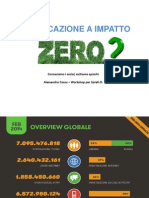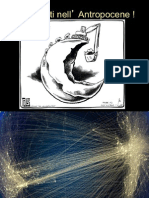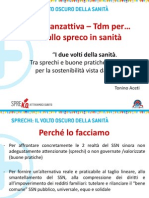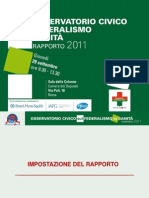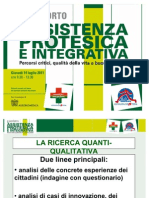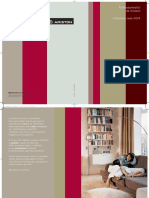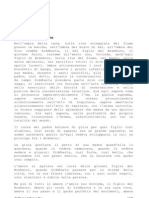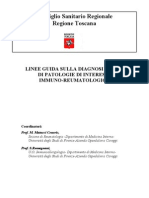Professional Documents
Culture Documents
K.O Allo Spreco Ambientale
Uploaded by
Cittadinanzattiva onlusOriginal Title
Copyright
Available Formats
Share this document
Did you find this document useful?
Is this content inappropriate?
Report this DocumentCopyright:
Available Formats
K.O Allo Spreco Ambientale
Uploaded by
Cittadinanzattiva onlusCopyright:
Available Formats
Marco Frey
Presidente Cittadinanzattiva
2
The challenge of sustainable development
arises from these two major converging trends
Decline in resource availability and
ecosystems
Impact = Population x Consumption
(Affluence) x Technology
Diminishing
margin for
action
Sustainability
Ehrlich, P.R. &
Holden, J.P.
(1974). "Human
Population and
the global
environment."
American
Scientist 62(3):
282292.
World population is
increasing to
unprecedented levels
Growing
resource use
Consumo di suolo in Europa
Il consumo di suolo
a livello europeo (2) p ( )
Aumento
superfici
artificiali
(2000-2006)
Superfici
artificiali
(2006)
E in Italia?
Ricoperti, negli ultimi 3 anni, altri 720 km2. In percentuale, e ormai
perso irreversibilmente il 7,3% del nostro territorio.
F
o
n
t
e
I
S
P
R
A
Tackling key resources and sectors
Water
Air
Minerals and metals
Biodiversity
Ecosystem services
Land and soils
Marine resources
Food
Housing / buildings
Mobility
Environmental Protection &
Resource Conservation
Economic
Prosperity &
Continuity
Social Well-Being & Equity
Whats Sustainability?
An unsustainable world
Con quali costi? Esempio consumo di suolo in Italia
La cementificazione ha comportato, dal 2009 al 2012, limmissione in atmosfera di
21 milioni di tonnellate di CO2 valore pari allintroduzione nella rete viaria di 4
milioni di utilitarie in piu con una percorrenza di 15.000 km/anno per un costo
complessivo stimato intorno ai 130 milioni di euro.
La trasformazione del suolo agricolo in cemento non produce impatti solo sui
cambiamenti climatici, ma anche sullacqua e sulla capacita di produzione agricola.
In questi 3 anni, per via della impermeabilizzazione del suolo, abbiamo perso una
capacita di ritenzione di acqua pari a 270 milioni di tonnellate che, non potendo
infiltrarsi nel terreno, deve essere gestita. E poiche 1 ettaro di suolo consumato
comporta una spesa di 6.500 euro (solo per la parte relativa al mantenimento e la
pulizia di canali e fognature), il costo della gestione dellacqua non infiltrata in
Italia, dal 2009 al 2012, e stato stimato intorno ai 500 milioni di Euro.
Ancora, il consumo di suolo produce forti impatti anche sullagricoltura e quindi
sullalimentazione: solo per fare un esempio, se i 70 ettari di suolo perso ogni
giorno fossero coltivati esclusivamente a cereali in Italia, nel periodo 2009-2012,
non avremmo dovuto impegnare 90 milioni di Euro per importare cereali
dallestero.
UNEP 2011 - Towards a Green
Economy
Pathways to Sustainable Development and
Poverty Eradication
The Green Economy Report demonstrates that the
greening of economies is not generally a drag on growth
but rather a new engine of growth; that it is a net generator
of decent jobs, and that it is also a vital strategy for the
elimination of persistent poverty. The report also seeks to
motivate policy makers to create the enabling conditions for
increased investments in a transition to a green economy
Read the report and understand the potentiality of this green growth
Decoupling growth and resource
consumption
13
Which of the following do you consider to be the single
most serious problem facing the world as a whole?
0
5
10
15
20
25
30
35
40
45
50
Poverty, hunger and lack
of drinking water
The economic situation Climate change International terrorism Others
Europe 2014
Europe 2011
Italy 2014
Italy 2011
14
SPECIAL EUROBAROMETER 409 Climate change
38
These results are broadly similar to those reported in 2011. There is no change in the
proportion of respondents who mention: buying local or seasonal produce whenever
possible; avoiding short-haul flights; and switching to an energy supplier that provides
more renewable energy. For each of the remaining actions there have been small
increases, most notably in the areas of cutting down on disposable items (+5 percentage
points from 46% in 2011) and choosing more energy-efficient household appliances (+4
points from 30%). This has led to a small drop since 2011 in the proportion of
respondents who say they have not carried out any of the actions (-3 percentage points
from 13%) and a corresponding increase in the proportion claiming to have undertaken
at least one of these actions (+4 points from 85%).
The Member States with the highest proportion of respondents who have taken some
form of action
20
are Luxembourg and Sweden (98% in each), followed by Denmark and
Germany (96% in each), and Slovenia and France (95% in each). Countries where
respondents are least likely to have taken action include Romania (61%), Bulgaria
(63%), Cyprus (72%), Lithuania (73%) and Portugal (76%).
Reducing waste and recycling on a regular basis is the most widespread action taken in
26 Member States, with the highest proportions of respondents reporting that they have
done so in Luxembourg (87%), Sweden (85%), France (80%), and Germany, Slovenia
and the UK (79% in each). It is least widely mentioned by respondents in Bulgaria
(23%), Romania (29%) and Latvia (33%). Bulgaria and Latvia are the two Member
States where other actions are more widely mentioned. In Bulgaria, these include
choosing energy-efficient household appliances (28%), cutting down on the consumption
of disposable items (27%), improving home insulation to reduce energy consumption
(23%) and reducing waste and regularly recycling it (23%). In Latvia, respondents are
most likely to mention buying locally produced and seasonal food whenever possible
(48%) and cutting down on the consumption of disposable items (36%).
20
Calculated by subtracting the None and Dont know responses from 100%.
Personal actions to fight climate change
RIO+20: Three events in one
Cupula dos povos
Rio+20 Corporate Sustainability Forum
Fonte: UN Global Compact Annual Review 2008
Who should take the leading role in influencing companies
Fonte: Eurobarometer, 2013
Integrate Corporate Sustainability into Business
People
Profit
Planet
The Corporate Sustainability Value Chain
Sustainability and Business Models
Has your organizations business model changed as a result of sustainability?
Sustainability and Business Models/cont
To the best of your knowledge, which of the following best describes the status of
sustainability on the agenda of your organization's top management?
Sustainability and Business Models
What factors have led to changes in your business model?
Sustainability and Business Models/cont
What elements of the business model has your company changed in connection
with sustainability?
Developing strategies to pursue sustainable development requires new approaches
Compartmentalized thinking - focused
on parts in isolation
Traditional Approach Sustainable Approach
Systems thinking - focused on
interdependence of parts and optimizing
whole system
Environment/social implications addressed
by staff specialist after strategic decisions
made
Environmental/social implications
considered by decision-makers in designing
strategy
Forecasting: where are we today- how do
we improve 5%
Backcasting: what would sustainable
world look like in 30 years how do we
get there?
Companys position is the way Stakeholder engagement to understand
diverse points of view to find better
solution
Integrating Sustainability Into Business Strategies
To maintain the integrity of these valuable services, we need to
understand how nature works
No
Waste
Nature works in cycles
There is no waste - what is
unused by one species becomes
nutrients for the next
The suns energy drives the
process:
o Green celled plants
using photosynthesis
create net concentration
and structure
Integrating Sustainability Into Business Strategies
/cont
In contrast, our industrial system functions primarily in a linear fashion
Take Make
Waste
Only 6% of
material
flow in ends
up in
products
Source: Hawken, Lovins, Natural Capitalism
Take natural capital,
structured valuable
material, and process it
into unusable waste
Integrating Sustainability Into Business Strategies
Leading companies are using eco-efficiency to integrate sustainability
considerations into their business
Definition
Delivering competitively
priced goods and services
that satisfy human needs and
bring quality of lifewhile
progressively reducing
environmental impacts and
resource intensity throughout
the life cycleto a level at
least in line with the earths
estimated carrying capacity.
Key Dimensions
Reduce material intensity of goods
and services
Reduce energy intensity of goods and
services
Reduce toxic dispersion
Enhance material recyclability
Maximize sustainable use of resources
Extend product durability
Increase the service intensity of
products, e.g. shared use, easily
upgraded
Source: DeSimone, Popoff: Eco-Efficiency
Integrating Sustainability Into Business Strategies
/cont
Creating shared value (Porter)
Policies and
operating practices
that enhance the
competitiveness of a
company while
simultaneously
advancing the social
and economic
conditions in the
communities in which
it operates.
Sharing
Houses
Travels
Meals
Projects
You might also like
- Focus Su Servizi Bancari e Assicurativi-PiT Servizi 2014Document28 pagesFocus Su Servizi Bancari e Assicurativi-PiT Servizi 2014Cittadinanzattiva onlusNo ratings yet
- PiT Servizi 2014 - Focus Su Telecomunicazioni e PosteDocument32 pagesPiT Servizi 2014 - Focus Su Telecomunicazioni e PosteCittadinanzattiva onlusNo ratings yet
- PIt Servizi 2014:focus Energia e AmbienteDocument33 pagesPIt Servizi 2014:focus Energia e AmbienteCittadinanzattiva onlusNo ratings yet
- Comunicazione A Impatto Zero-Alessandro CossuDocument17 pagesComunicazione A Impatto Zero-Alessandro CossuCittadinanzattiva onlusNo ratings yet
- Farmaci: Accesso, Equità, Sostenibilità, InnovazioneDocument22 pagesFarmaci: Accesso, Equità, Sostenibilità, InnovazioneCittadinanzattiva onlusNo ratings yet
- Relazione Apertura Sprechi in Sanita'Document52 pagesRelazione Apertura Sprechi in Sanita'Cittadinanzattiva onlusNo ratings yet
- Gli Sprechi Ambientali e La Difesa Del SuoloDocument7 pagesGli Sprechi Ambientali e La Difesa Del SuoloCittadinanzattiva onlusNo ratings yet
- Pit Servizi 2014-Focus Mobilità e TrasportiDocument31 pagesPit Servizi 2014-Focus Mobilità e TrasportiCittadinanzattiva onlusNo ratings yet
- Rapporto PiT Salute 2014 " (Sanità) in Cerca Di Cura"Document38 pagesRapporto PiT Salute 2014 " (Sanità) in Cerca Di Cura"Cittadinanzattiva onlus100% (2)
- La Qualità Alimentare e Gli Stili Di Vita Nelle ScuoleDocument9 pagesLa Qualità Alimentare e Gli Stili Di Vita Nelle ScuoleCittadinanzattiva onlusNo ratings yet
- Osservatorio Civico Sul Federalismo in Sanità 2012Document36 pagesOsservatorio Civico Sul Federalismo in Sanità 2012Cittadinanzattiva onlusNo ratings yet
- XI Rapporto CnAMC-Cittadinanzattiva, I Principali Risultati - Maria Teresa BressiDocument26 pagesXI Rapporto CnAMC-Cittadinanzattiva, I Principali Risultati - Maria Teresa BressiCittadinanzattiva onlusNo ratings yet
- SPRECHI ALIMENTARI: Relazione Introduttiva Di Riccardo ValentiniDocument33 pagesSPRECHI ALIMENTARI: Relazione Introduttiva Di Riccardo ValentiniCittadinanzattiva onlusNo ratings yet
- Sprechi: Il Volto Oscuro Della Sanita'Document9 pagesSprechi: Il Volto Oscuro Della Sanita'Cittadinanzattiva onlusNo ratings yet
- Disponibili! Una Mobilitazione Di Cittadini Per Il Riuso Dei Ben AbbandonatiDocument21 pagesDisponibili! Una Mobilitazione Di Cittadini Per Il Riuso Dei Ben AbbandonatiCittadinanzattiva onlusNo ratings yet
- Percorso Nascita: I Principali RisultatiDocument41 pagesPercorso Nascita: I Principali RisultatiCittadinanzattiva onlusNo ratings yet
- IV Indagine Rischio SismicoDocument21 pagesIV Indagine Rischio SismicoCittadinanzattiva onlusNo ratings yet
- Emergenza Famiglie: L'insostenibile Leggerezza Del WelfareDocument21 pagesEmergenza Famiglie: L'insostenibile Leggerezza Del WelfareCittadinanzattiva onlusNo ratings yet
- X Rapporto Sulla Sicurezza Scolastica Di Cittadinanzattiva "Impararesicuri"Document13 pagesX Rapporto Sulla Sicurezza Scolastica Di Cittadinanzattiva "Impararesicuri"Cittadinanzattiva onlusNo ratings yet
- Oncologia: Personalizzazione, Rispetto Del Tempo, Consenso Informato. Focus Sul Cancro Al Colon RettoDocument26 pagesOncologia: Personalizzazione, Rispetto Del Tempo, Consenso Informato. Focus Sul Cancro Al Colon RettoCittadinanzattiva onlusNo ratings yet
- Servizi e Cittadini: Lo Spread Dei Diritti - XII Rapporto PiT Servizi, 2012Document42 pagesServizi e Cittadini: Lo Spread Dei Diritti - XII Rapporto PiT Servizi, 2012Cittadinanzattiva onlusNo ratings yet
- X Rapporto Sulla Sicurezza Scolastica Impararesicuri - Le ProposteDocument7 pagesX Rapporto Sulla Sicurezza Scolastica Impararesicuri - Le ProposteCittadinanzattiva onlusNo ratings yet
- La Salute Nella Costituzione, Di Giovanni Maria FlickDocument6 pagesLa Salute Nella Costituzione, Di Giovanni Maria FlickCittadinanzattiva onlusNo ratings yet
- SonoUnVIp - Inps e Invalidità: Le Verità Dei NumeriDocument14 pagesSonoUnVIp - Inps e Invalidità: Le Verità Dei NumeriCittadinanzattiva onlusNo ratings yet
- Angelo Tanese, Agenzia Valutazione Civica, I Rapporto Su Assistenza Protesica e IntegrativaDocument14 pagesAngelo Tanese, Agenzia Valutazione Civica, I Rapporto Su Assistenza Protesica e IntegrativaCittadinanzattiva onlusNo ratings yet
- Impararesicuri 2011 - IX Edizione, Presentazione Principali Dati Di Adriana BizzarriDocument19 pagesImpararesicuri 2011 - IX Edizione, Presentazione Principali Dati Di Adriana BizzarriCittadinanzattiva onlusNo ratings yet
- Osservatorio Civico: Rapporto 2011 - L'impostazione Del Lavoro e Il Quadro Regionale - Angelo TaneseDocument19 pagesOsservatorio Civico: Rapporto 2011 - L'impostazione Del Lavoro e Il Quadro Regionale - Angelo TaneseCittadinanzattiva onlusNo ratings yet
- Osservatorio Civico Sul Federalismo - Rapporto 2011. Presentazione NardiDocument25 pagesOsservatorio Civico Sul Federalismo - Rapporto 2011. Presentazione NardiCittadinanzattiva onlusNo ratings yet
- I Rapporto Su Assistenza Protesica e Integrativa - Rosapaola MetastasioDocument28 pagesI Rapporto Su Assistenza Protesica e Integrativa - Rosapaola MetastasioCittadinanzattiva onlusNo ratings yet
- Polimeri Di Nylon 6 e 66 Per Uso TessileDocument31 pagesPolimeri Di Nylon 6 e 66 Per Uso TessileAlessio Scarabelli100% (1)
- TGM Cap1 23Document41 pagesTGM Cap1 23OkNo ratings yet
- 7 Peccati Capitali Nuova VisioneDocument7 pages7 Peccati Capitali Nuova VisioneClaudioNo ratings yet
- Cat Gen Bi 2004Document38 pagesCat Gen Bi 2004SissyNo ratings yet
- A. Lugli - MuseologiaDocument6 pagesA. Lugli - MuseologiaMiriam TolentinoNo ratings yet
- Allestimento Di Colture BattericheDocument6 pagesAllestimento Di Colture BattericheMatteo BarinNo ratings yet
- Siddharta - Hesse (Book-Trailer ITA)Document15 pagesSiddharta - Hesse (Book-Trailer ITA)Mónica FioriNo ratings yet
- Fucinatura IntegrataDocument73 pagesFucinatura IntegratapfmgNo ratings yet
- LGImmunoreumatologiaDocument95 pagesLGImmunoreumatologiaZachary HowardNo ratings yet
- Muscoli ElencoDocument10 pagesMuscoli ElencoMED4HOPENo ratings yet



